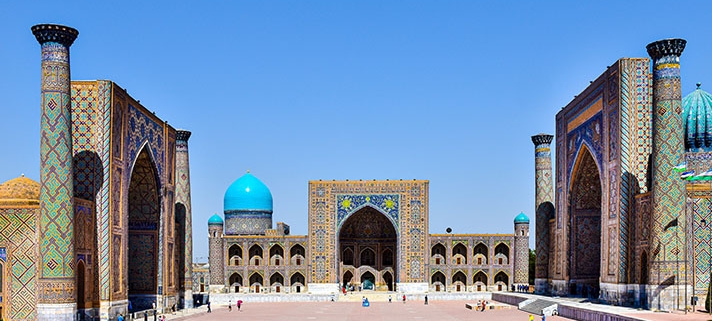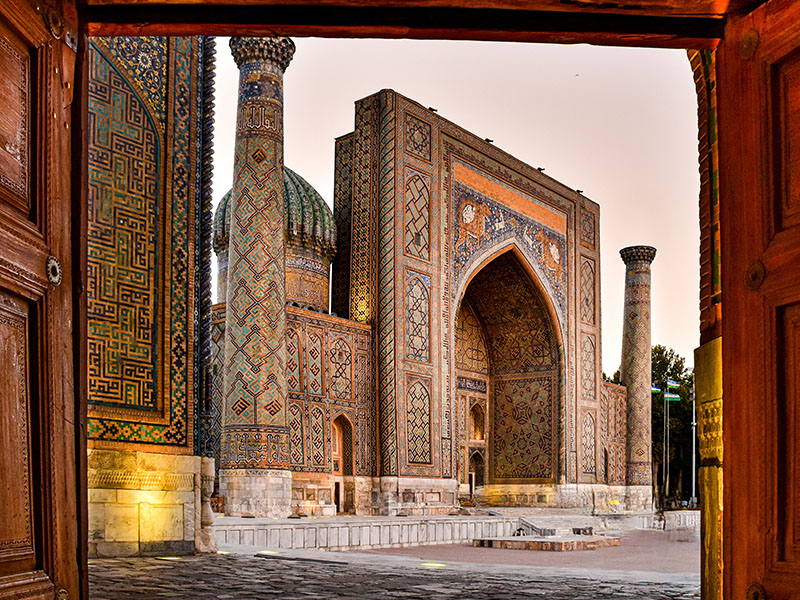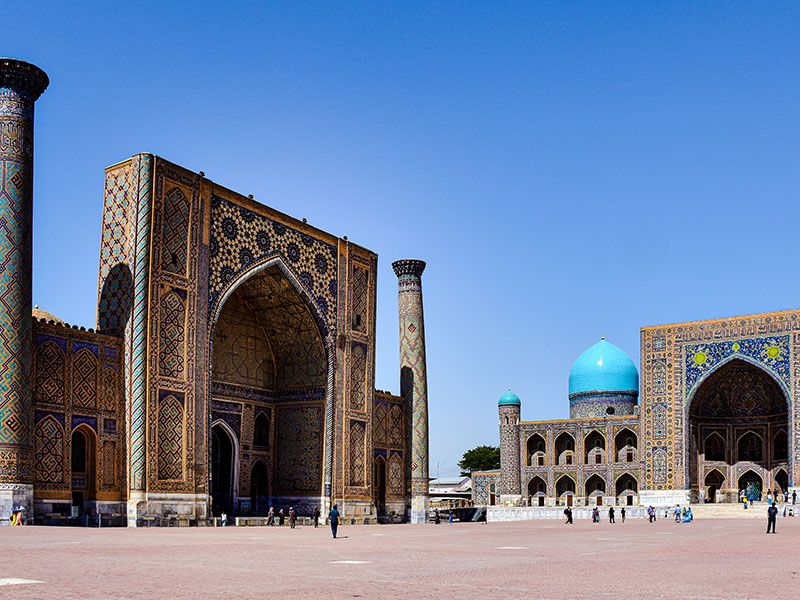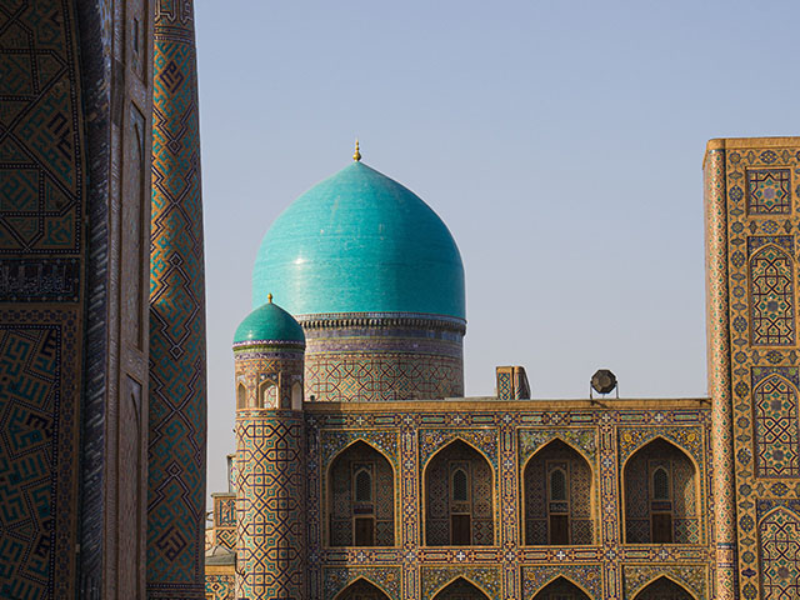Registan Square Samarkand, Uzbekistan: Photos, History
Samarkand Registan Square is among the most magnificent tourist attractions of Uzbekistan, which has Iranian roots, and due to the high age of this area, it has been officially registered in the UNESCO world list. Uzbekistan was one of the countries that were a subsidiary of Iran in the past, and the atmosphere in this country is Iranian. The ancient city of Samarkand is considered one of the most trafficked tourist cities, which hosts many travelers every year with its huge and magnificent ancient structures.
When was Registan Square Built?
The year of construction of Registan Square is not known precisely, but it dates back to the 15th century, and more than 500 years have passed since the construction of this huge building. Three schools in Registan Square were built later between the 15th and 17th centuries. There are three schools around Registan Square, all three of which are the main attractions of Samarkand city. Schools around Registan were built in different eras by two rulers.
Ulugh Beg Madrasa
Ulugh Beg was the heir of the Timurid Empire, a prominent mathematician, and astronomer who took power in 788 AH. Eight years later, he ordered to build of a school near Registan Square, and later, this school was renamed in his honor. This school was the first building built near Registan and its western part. In 799, the construction of the school was completed. At that time, Ulugh Beg Madrasa was considered the largest scientific-educational center in Samarkand, and an array of sciences was taught there, such as philosophy, mathematics, astronomy, and theology.
The entrance porch of Ulugh Beg Madrasa, with its two tall minarets on both sides, is a view that can be seen from the Registan. The school is built in the shape of a rectangle. Upon entering, you will see the entrance of the school decorated with ten-pointed stars. These stars are a symbol of the sky and astronomy. After entering the school, you will see a square courtyard that leads to students’ rooms and classrooms, and each room can accommodate about 100 people. The interior architecture of the school is very original and exquisite. The shiny tiles stand out among the yellow walls of the school.
Sher-Dor Madrasa
In 991 AD, Yalangtush Bakhodur was appointed as the emir and ruler of Samarkand. He was an intelligent politician and a trained commander. The ruler of Samarkand decided to build another school in front of Ulugh Beg Madrasa. As planned by the architects, the new school would be a reflection of the Ulugh Beg. For this reason, Ulugh Beg was considered to be constructed in the eastern portion of the square.
However, the precise and mirror construction of the building did not make them create a similar structure on the east side of the Registan. Because due to the passage of time over the past two centuries, the form of the square and the school had changed in such a way that the height of the school was reduced. The level of the square was two meters higher. That is the reason why the new school was built a little taller.
The construction of this school lasted until 1015. Contrary to the fact that the facade of Sher-Dor Madrasa is similar to Ulugh Beg, new methods, and technologies were used for its construction, which was not common in the 14th century and accelerated the construction of the school.
The school was named in honor of the ruling party of the city, but that name never caught on among the people, and everyone knew the school as Sher-Dor. This name was derived from the image of lions on the school door and its entrance porch. Above the porch, two golden lions carrying the sun on their backs and looking for a white gazelle can be seen. Later, the same emblem of the lion and sun was used in the flags of Iran and Uzbekistan.
Tillya Kori Madrasah
Ten years after the construction of the Sher-Dor, the Emir of Samarkand decided to build another building near Registan. The construction started in 1025 AD in the northern region of the square. The designer of the new building, keeping all the features of the previous two buildings, presented a plan for the new building to be visible from Registan Square.
The construction of Tillya Kori Madrasah took more than 14 years and was completed in 1039 AH. The school’s main gate is a huge and beautiful niche with two entrances to the school’s inner courtyard.
On the left side of the main gate is a mosque with a blue dome with two minarets on both sides of the main gate. Despite the presence of a new building, the design of the new school can maintain a balance between the two schools without disturbing the harmony of their architectural style. Among the three schools, the architecture of Tillya Kori is unique.
Why is Registan Square Famous?
Registan Square owes its world fame to the unique Iranian architecture of the buildings around it, which itself is a symbol of extraordinary oriental architecture. Interestingly, the architectural influence of the Registan and its surroundings can be seen in other parts of the world besides Iran. From the famous marble, Taj Mahal in India to the 20th-century mosque of St. Petersburg, Russia, the Registan architecture is visible.
Registan Square is surrounded by a ring of huge and unique schools on three sides, each with a unique design and architecture. The entrance of all three schools is towards Registan square. One of the reasons why Samarkand was included in the UNESCO World Heritage List in 2001 was the existence of these buildings with unique architecture.
Registan Square Fun Facts
Before the construction of the square, there was a river that dried up, and only its sand remains; Registan means a land full of sand and gravel, and that is why it is called Registan. This magnificent square was the central square of the city of Samarkand, and from the beginning, school buildings were not located around it.
In the olden days, the main squares played a significant role in the people’s social life and were considered the community’s beating heart. Many important events were held in the main square of the city. Registan Square was no exception to this rule. At that time, the rulers of the city used Registan Square to announce government statements, and people gathered in Registan to hear and learn about Khan’s orders.
In addition, Registan was the place of public celebrations. In a part of the square, there was a wooden structure for public punishment and execution. Another use of the square was to gather military forces for war, and commercial lines were also very visible around Registan square.
In Samarkand, all the main and important roads used to lead to Registan Square, and not all that commotion and life were without reason. In different periods, the rulers had various policies that caused the importance of the Registan to decrease or increase. But since then, Registan has remained the main center of the city’s social life. Today this square has become world famous, and many music concerts, public celebrations, and other public events occur here.
Other Buildings Near Registan Uzbekistan
Shaybanid Mausoleum
In the eastern part of Tillya Kori Madrasah, there is the Shaybanid Mausoleum, which belongs to the 10th century. Muhammad Shaybani was the founder of the Shibanids dynasty, a descendant of Genghis Khan, who fought with the Timurid ruler of his time and was the cause of ethnic and religious wars.
Are you planning to travel to Uzbekistan? Check out our Uzbekistan tour. Maybe you will find interesting things to do in Samarkand.










Good luck :)